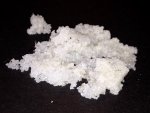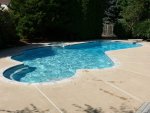Hi All,
We did a pool renovation last summer (August 2014), I closed the Pool on 9/20/14 with a PH of 7.2. The pool was opened yesterday and after opening yesterday and running the pump for 5 hours:

I am currently using CL tabs and once this is resolved I will add the salt and convert over to the SWG.
On the walls of the pool I have deposits with a texture similar to sand, I was able to brush these off and vacuum them out, see pic

If this is scaling did the minerals come out of the finish or the water?
Will keeping the PH at 7.5 during the season help dissolve whatever scaling might be there?
The deposits in the SPA are firmly attached and will not brush off, could the issue in the SPA be more serious due to the lower volume of water or difference in temperature over the winter?
What is the best way to remedy the SPA; I have read that an Acid wash or the use of a Pumice stone could make the surface smoother. I am leaning towards a Pumice stone, the spa is small and shouldn't take too long. Is the Stanley Pool Tec stone recommended?
Amazon.com : Stanley 36897 Pumice Stone - Large : Swimming Pool Cleaning Tools : Patio, Lawn Garden
Thanks,
Jim
We did a pool renovation last summer (August 2014), I closed the Pool on 9/20/14 with a PH of 7.2. The pool was opened yesterday and after opening yesterday and running the pump for 5 hours:
I am currently using CL tabs and once this is resolved I will add the salt and convert over to the SWG.
On the walls of the pool I have deposits with a texture similar to sand, I was able to brush these off and vacuum them out, see pic

If this is scaling did the minerals come out of the finish or the water?
Will keeping the PH at 7.5 during the season help dissolve whatever scaling might be there?
The deposits in the SPA are firmly attached and will not brush off, could the issue in the SPA be more serious due to the lower volume of water or difference in temperature over the winter?
What is the best way to remedy the SPA; I have read that an Acid wash or the use of a Pumice stone could make the surface smoother. I am leaning towards a Pumice stone, the spa is small and shouldn't take too long. Is the Stanley Pool Tec stone recommended?
Amazon.com : Stanley 36897 Pumice Stone - Large : Swimming Pool Cleaning Tools : Patio, Lawn Garden
Thanks,
Jim


